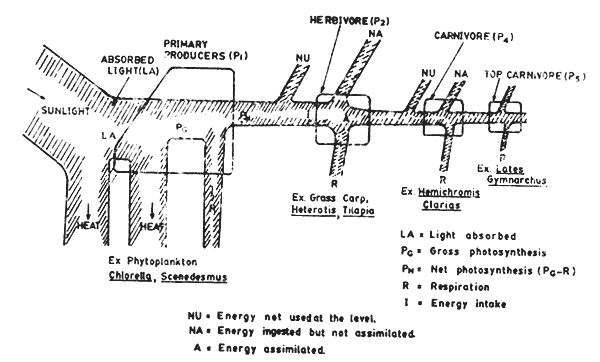The biological productivity of aquatic systems, as of land, has been at several levels, the basic or primary productivity which is again divisible into gross and net primary productivity, and secondary productivities at the various trophic levels (discussion preceding). Basic or primary productivity, is defined as the rate at which energy is stored by photosynthetic activity of producer organisms (chlorophyll bearing organisms, mainly plants and phytoplankton) in the form of organic substances which can be used as food substances.
Gross primary productivity is the total rate of photosynthesis including organic matter used up in respiration during the measurement period (also known as total photosynthesis or total assimilation). Net primary productivity is the rate of storage of energy as food matter i.e. excluding the energy dissipated as respiration by plants (also referred to as “apparent” photosynthesis or net assimilation). Usually a value obtained for the rate of respiration of plants is added to apparent photosynthesis to obtain estimates of gross primary productivity.
The rates of energy storage at trophic levels of consumers and decomposers are referred to as “secondary productivities”; these rates as already indicated are less and less at each succeeding trophic level. To be correct, at secondary productivity level, there is only 'assimilation of food already produced by the autotrophs (plants) at each succeeding trophic levels (heterotrophs) and as such the term ‘productivity’ should not be associated with these trophic levels.
The term “productivity” is always used in this context to mean ‘rate of production’ or ‘rate of energy flow’. Gross production (PG) and net production (PN) are secondary productivities (P2 - P5) are indicated in the figure (energy flow) (Fig. 10.3).
It must be emphasized that ‘productivity’ refers to the rate of production or rate of energy flow and therefore ‘richness’ of the water-body or ecosystem; this cannot be judged solely from the ‘biomass’ of crop (standing crop) of organisms at various trophic levels.
A large biomass or standing crop need not be related to be related to high productivity. From this context the concept turn-over rate is important.
It is obvious that gross and net production rates would change with the richness of the water body. Productivity can vary from less than 1 g carbon (C)/M2/day-1 in the open sea (deep lake) to over 60 g C/M2/day-1 in natural and artificial systems.
Gross productivity of some of the water bodies, adapted from Odum (1959), are indicated:
| Open ocean (long term) | : | 0.5 g/m2/day |
| Shallow inshore water | : | 3.2 |
| Tidal estuaries | : | 4.4 |
| Coral reefs | : | 18.2 " |
| Pond-with untreated sewage | : | 27.0 " |
| Mass algal culture | : | 43.0 " |
| Polluted stream | : | 57.0 " |
It is seen that a very large portion of the earth's surface (ocean & grass lands) are of low productivity. Certain areas like the shelf area, arella moderately or highly productive as are the coral reefs. In the latter the plant-animal symbiosis results in very fast turnover of nutrients causing very high productivity.

Fig. 10.2. Diagram showing energy flow in an ecosystem indicating various levels of productivity in gross primary production (PG), net primary production (PN) and secondary production, P2, P3, P4 & P5 - decomposer not indicated (Modified from Odum, 1959) (size relations in sketch not to scale)